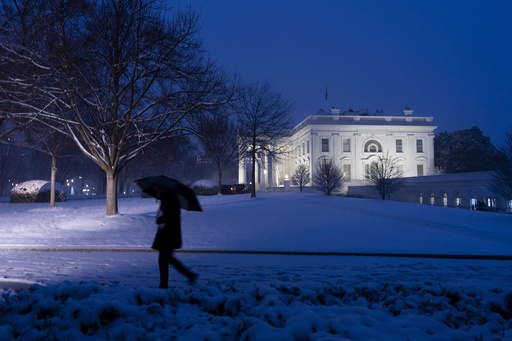Meteorologists are alerting that an intense wave of Arctic air is set to sweep across the United States, marking a notable surge in what has been a winter characterized by repeated polar vortex incursions. This cold spell is expected to linger throughout the upcoming week.
Weather systems in the Arctic are converging, pushing frigid air usually confined near the North Pole not only into the U.S. but also affecting Europe, according to expert assessments. This marks the 10th intrusion of the polar vortex this winter, a significant increase compared to the typical two or three occurrences in a standard winter season, explains Judah Cohen, the seasonal forecast director of a private meteorological firm.
This winter has been anything but ordinary, highlighted by record snowfall in New Orleans, alongside drought conditions and devastating wildfires in Southern California. The impending cold outbreak is anticipated to commence in the northern Rockies and the northern Plains, making its presence felt by Saturday and persisting into the following week. Forecasters suggest that the severe cold will primarily impact areas east of the Rockies, with central and southern Florida and portions of far western America expected to remain largely insulated.
On Tuesday, meteorological analysis indicates that the average low temperature across the contiguous United States will hover around 16.6 degrees Fahrenheit (minus 8.6 degrees Celsius), declining further to about 14 degrees Fahrenheit (minus 10 degrees Celsius) by Wednesday, as calculated by former National Oceanic and Atmospheric Administration chief scientist, Ryan Maue.
Next week, projections reveal that an overwhelming 89% of the contiguous United States will experience temperatures below freezing, with 27% likely dipping below zero degrees Fahrenheit (minus 18 degrees Celsius), based on forecasts from the National Weather Service. Wind chills are expected to exacerbate uncomfortable conditions, with every state aside from Hawaii, California, and Florida at risk for potential wind chills falling to 20 degrees Fahrenheit or lower at some point next week.
Specific states such as Kansas, Nebraska, Missouri, and Iowa are predicted to experience particularly severe cold, with temperatures plummeting as much as 35 degrees Fahrenheit (19 degrees Celsius) below seasonal averages. Meteorological models from NOAA forecast that Wednesday lows will plunge below zero in several states, including Oklahoma, Colorado, Nebraska, and multiple others extending into the Midwest and upper Northeast.
While some winter storms—including heavy snowfall or flooding—might coincide with this prolonged cold snap, specifics surrounding those events are currently unclear. According to Maue, all atmospheric conditions seem to align, drawing the cold polar air southward from the Canadian Arctic, presenting what is likely to be the most extreme cold wave of the winter thus far.
It is important to distinguish between polar vortex stretching—occurring lower in the atmosphere—and significant weakening phenomenon that allows cold air to escape from the poles. During stretching events, the polar vortex remains intact but can bend, leading to outbreaks that typically affect the U.S. rather than Europe, as noted by Cohen.
Meteorologists are eager to investigate the frequent stretching occurrences this year, which might simply reflect natural variability, according to Laura Ciasto, a NOAA specialist. Similar sentiments are echoed by Martin Stendel, a researcher from Denmark, who acknowledges that while the current conditions are intriguing, they are not unprecedented.
Another contributing factor may be a significant area of high pressure in the upper atmosphere over Greenland, which is shifting westward and influencing the jet stream—vital in disseminating weather systems—to adopt a pattern conducive to maintaining polar air in the U.S. Some experts speculate that human-induced climate change might be causing the jet stream to adopt a more erratic trajectory, resulting in these prolonged cold situations.
Given the distinctive nature of this winter, forecasts regarding the duration and eventual easing of this cold spell remain difficult to ascertain. Despite the chilling temperatures in the U.S., the overall global trend indicates rising temperatures, with Earth’s average temperature setting a new record in January, constituting the 18th month in the last 19 to either reach or exceed the 1.5 degrees Celsius warming threshold established internationally.


